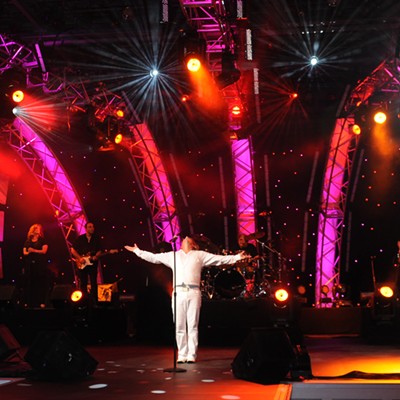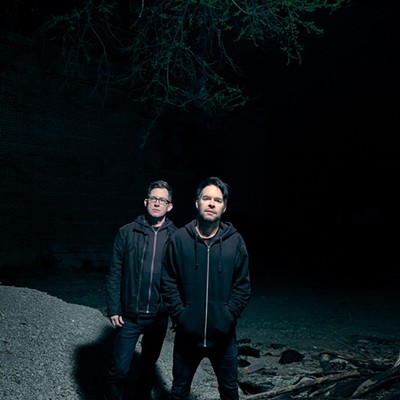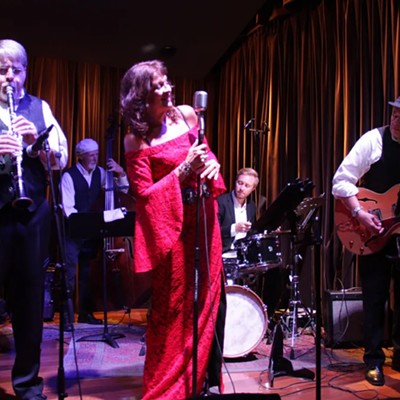Little could he have known that in short order, the Dead would actually become his day job, allowing that part of his life to more fully support his other more exotic and percussive pursuits.
"Garcia used to call it my enthusiasms," he reminisced in a recent phone interview, referring to how bandmate Jerry Garcia would view his passions for tribal and primal rhythms and his search for the people and instruments responsible. It's a journey that has taken him all over the world, collecting hundreds of indigenous rhythmic instruments while making countless field recordings along the way. Much of this has been documented in his books Drumming at the Edge of Magic and Planet Drum, the latter a companion piece to his 1991 recording of the same name.
But first and foremost, Hart is a musician. With the pending release of Global Drum Project, the sixth album released under his name and supervision (not including the soundtrack to Apocalypse Now), his artistry continues to evolve.
His first solo effort was Rolling Thunder. Released in the midst of one of the Dead's most creative periods in 1972, it brought the cream of San Francisco's rock community (including horn players) together with tablas, talking drums, marimba and a variety of hand percussion.
"I had a studio, and people were always passing through, and so this was a very communal record, like a (Jefferson) Starship kind of record." More significant, however, was that it was his initial collaboration with Zakir Hussain. The son of his teacher Alla Rakha, Hussain, barely into his 20s, was already a master of the tablas (traditional Indian finger drums).
"My association with Mickey spans a lifetime," writes Hussain in the current Global Drum Project liner notes. "It was a rebirth of sorts when I met him, a new phase in my learning process."
In terms of recorded drumming, however, Rolling Thunder was but the tip of the iceberg compared to Hart's next "solo" outing, the Diga Rhythm Band. "Diga ... that was certainly the seed for this," said Hart. That was the genesis for a lot of things.
"Diga also had a lot of Zakir's tabla students. And I've always been after that 21st-century kind of percussion orchestra ... the world of drums coming together in a beautiful groove. (This was) a powerful beginning."
But where Rolling Thunder also expressed some legitimate rock 'n' roll songs, Diga made no such pretense. More than anything, this record was about drumming and the harmonious complexities of rhythm made by outstanding drummers. Some consider it the first contemporary world music album.
Like some other solo projects from the Dead, Diga was received with polite courtesy, and it would be another 15 years before the first Planet Drum record would be released. Unlike Diga, with drums and drumming now much more en vogue, that new project garnered significant critical acclaim. Several years later, a second Planet Drum album, Supralingua, was released. "In some ways, that was the predecessor to this, because that's when we began bringing electronics into Planet Drum."
Now there is the Global Drum Project, and this is what excites Hart the most. "Like the last one, this has a good backbeat, but this is softer. That's what we were after, and we wanted to explore that.
"I'm also used to being in a great dance band, so how do you combine the dance with these great virtuoso players and have them agree to just groove and have a conversation within that groove like that? That's really the trick. Fortunately, we know each other so well now, we have the group mind. And when we have that, anything is possible!"
Because of that, there is also a hypnotic element to the new recording. This is enhanced by some new technologies but not dominated by them. Fortunately, the effect is subtle.
"Each time I have tried it (Planet Drum), it's progressed a little bit. With this CD, we've added more of the electronic element to the archaic drums, and we've come up with this mood thing. It's not about drum solos but about coming together for some kind of mood or a trance. It's more like processed percussion as opposed to synthesis. We've tried to hybridize the archaic world of percussion, but without the machines taking over. It's a different kind of stew."
Adding to this percussive gumbo are Giovanni Hidalgo on Latin percussion and Sikiru Adepoju on talking drum. Unlike previous Planet Drum tours, they will not be joined by other supporting musicians but will look to re-create and translate their work from the CD onto the stage themselves. Hart acknowledges this is new territory, but he seems to relish the challenge.
"How do you take something that's been created in a studio setting using very sophisticated digital technology and then take it on the road? It's really a great experiment on how a four-piece can become a percussion orchestra."
Hart also emphasized that Jonah Sharp, who is credited with digital production on the new CD, will play a key role in this process.
This current tour, which will begin in Tucson, will also differ from previous tours in that while there may be some chanting and vocals, "It's not about singing. We come to drum." At the same time, Hart acknowledges, "This is different but accessible. ... You don't have to be into hardcore percussion to like it."
As for his old day job, Hart acknowledges his good fortune.
"I could make a living playing the music I love in the Grateful Dead and also satisfy the drum gods." One suspects the gods must be pleased.







